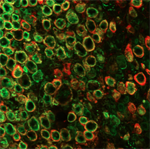 Muscle weakness can be caused by a rare inherited disease called myofibrillar myopathy. Gonzalo Blanco’s team found a mouse model of this disease and wanted to identify the underlying cause of the severe muscle weakness. Their aim was to discover potential therapeutic targets to translate into pre-clinical and clinical studies.
Muscle weakness can be caused by a rare inherited disease called myofibrillar myopathy. Gonzalo Blanco’s team found a mouse model of this disease and wanted to identify the underlying cause of the severe muscle weakness. Their aim was to discover potential therapeutic targets to translate into pre-clinical and clinical studies.
Before I became involved, the disease had been mapped to a large region of one chromosome and Dr Blanco’s team were planning to use conventional positional cloning methods to find the mutation. I proposed that a faster approach would be to use next-generation sequencing targeted at genes in the region. I designed a set of probes to enrich specific DNA fragments and I worked with a bioinformatician, 博士. Michelle Simon, to design a software pipeline to find and characterise mutations.
At the end of the design process, the pipeline was used to identify mutations in the muscle weakness mutants and predict that they altered the coding sequences of two genes; Myh4 和 Pmp22. Two lines of evidence suggested that the mutation in Myh4, which codes for a muscle myosin protein, was the most likely cause of the weakness. Firstly, our colleagues found that mice carrying only the myosin mutation still had the trait and secondly, abnormal protein aggregates from affected mice contained large amounts of the myosin.
Scientists at the MRC’s Mammalian Genetics Unit have used the same approach, that Michelle Simon and I pioneered, to find mutations in other disease models.
Publication in Human Molecular Genetics
Testimonial from 博士. 貢薩洛·布蘭科
